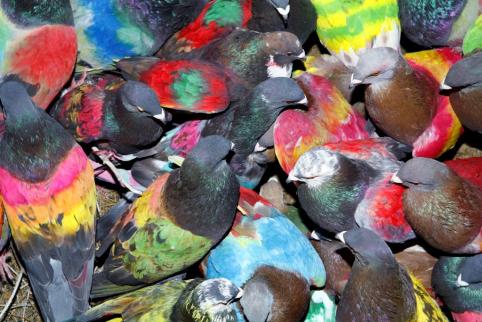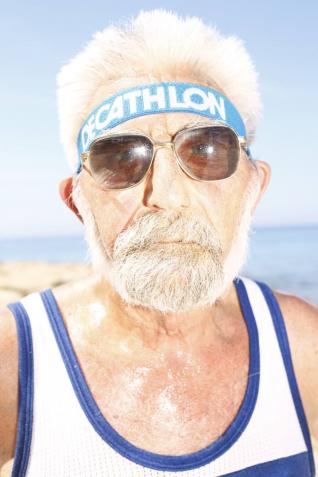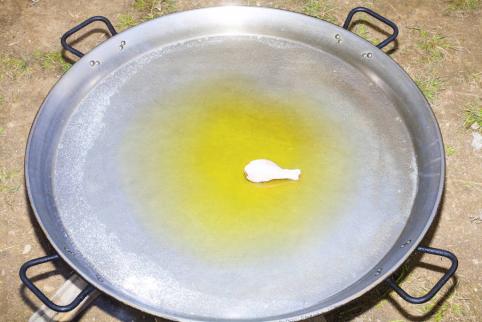
Ricardo Cases is a Spanish photographer. He was born in 1971 in Orihuela in the Alicante province on the Mediterranean coast. He started out as a reporter and in the 2000s became a leading light in the rebirth of Spanish contemporary photography, in particular as part of the Blank Paper collective. His 2011 book Paloma al aire, thrust him onto the international stage. It chronicles the activities of pigeon fanciers in the Valencia region of Spain taking part in an unusual local race where the male birds are painted in bright colours.
The ”Estudio elemental del Levante” (An Elemental study of the Levante) was his first solo show. It took place in Madrid in July 2018, and was a retrospective of five series the photographer did in the Levante – the Spanish Mediterranean coast – over a period of eight years. Ricardo Cases takes an interest in his environment but his work is not reduced to its documentary function, to the recorded fact. Instead, he explores all of the photograph’s semantic possibilities. His work features blinding lights, explosive colours, damaged objects, and decadent characters, revealing the visual singularity of this “undisciplined, fascinating and hallucinogenic country.”
The first impression of Ricardo Cases’ photographs is fun, but they allow the viewer to get beyond stereotypes, to get to a deeper level, that highlights the shortcomings of the region. They may be set in a specific geographical perimeter, but these photographs have a universal reach in terms of the way territories change, their feeling of nostalgia and the way they respect local treasures and traditions.
From his first works, Ricardo Cases’ particular creation has been filled with radicalism, vitality and humour, and it is imbued with an anthropological and ultimately tender view of his subjects, which are always involuntary representatives of the Spanish nature.
This intuitive photographer honed his process until he managed to be several steps ahead of himself and capture truths that it would then take him months to decipher. His latest work flies higher, with a more sophisticated language that takes a much higher artistic risk, but always with a playful background that still inspires our capacity for wonder and conveys his enthusiasm for photography (and for life in a wider sense) seen as a game. In all these years of work, his critical and yet sincere fascination with the Iberian spirit has created, in the life-sized laboratory of the orchards of Valencia, a complex repertoire that contains the keys of Spain, but especially the keys of the Spanish nature.
After receiving the Culture Award of the Community of Madrid in 2017, this is the first opportunity to contemplate such a wide and coherent sample of his work. The collection of series including Paloma al aire [Pigeons in Flight], Podría haberse evitado [It Could Have Been Avoided], Estudio elemental del Levante [An Elemental Study of the Levante], Sol [Sun] and El porqué de las naranjas [The Reason for Oranges] constitutes a powerful symbolic corpus that gives shape to the universe of Levante as
a colourful, anarchic, wild and confusing place. Welcome to this eerie Wonderland.
Paloma al aire
2011
These are the rules of the game: a female pigeon is released and several dozens
of male pigeons chase after her trying to get her attention. Although none of them ever gets too intimate, the winner is the one that spends the longest close to her. The winner is not the most athletic, the toughest or the purest in breed, but the most courteous, the one showing more constancy and having the strongest reproductive instinct: the macho.
On the domestic scale of a rural and rather marginal hobby, pigeon breeding and racing offers us images of hope and longing which, out of context, take on a greater, universal, meaning. Men looking up at the sky, with their gaze trained on the flight of their pigeons, their life projectile: their bet, their bullet, their lottery ticket.
Estudio elemental del Levante
2018
Making the infection visible. Like Bosch, confessing the sin as a condition for forgiveness.
When did the Levante go to hell?
The triangle created by the palm tree, the municipal band and the palm weevil defines the spiritual map of the systemic crash of contemporary Spain, of a violent and screeching collision. Everything shapes a dissonant symphony. In the images themselves we can hear the shrill scream of metals as a desperate alert.
Podría haberse evitado
2015
A Southern tragedy clearly occurred before our eyes. The corpse may have already been hidden, and who will find it here? We may have arrived too late.
When suspicion emerges, when trust has been shaken, everything becomes suspicious, forever.
The investigator must assume that behind the public space looms the clandestine, that there is always a secret plan, that there is always a skeleton in the closet. Recording everything becomes a civic responsibility. However, these photographs do not prove anything either. When suspicion appears, it brings about a side effect: the sense of reality becomes blurred. This document could be a construction, yet another lie. Once trust has been shaken, everything is suspicious, everything is paranoia.
Is it possible that they could in this way escape once again?
Sol
2017
I was born on a planet dominated by a star that looms too close. My sky is circled
by a massive ball of fire that I don’t dare look at directly. My scorched retina stores layer upon layer of engraved images, a palimpsest of everything I ever saw that impressed me. My land is sun- baked, parched, desolate. I have grown accustomed to living with its burning breath on my neck, my head hung down in shame. I’m alone in my desert with my light fossils and my star that scorches, sterilises and kills it all.
El porqué de las naranjas
2014
Sometimes, reality reveals its innards in ephemeral moments that go by unnoticed. When documenting the surface is not enough to understand our circumstances, it becomes necessary to open our perception and be alert for those signs. What is man? What does it mean to be Spanish? Is there any salvation or solution for us? In the orchards of Valencia, a scale laboratory of contemporary Spain, life sometimes turns one of its cards and shows it to us to mocks us even more as it fleeces us. This collection of pictures is what the photographer has been able to glimpse from that pack of cards.
Curator/ Horacio Fernández
Text / Luis López Navarro
Exhibition Design and Mounting / Anne-Céline Borey, Emmanuelle Vieillard, Musée Nicéphore Niépce
Graphic Design / Le Petit Didier
Framing / Ros Marcos
Digital Printer / La Troupe
Museographic Production / Martínez & Martínez
Translation / David González-Iglesias, Catherine Kellogg
Production of the exhibition / Comunidad de Madrid








